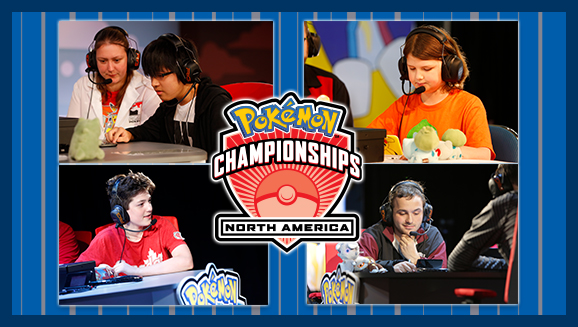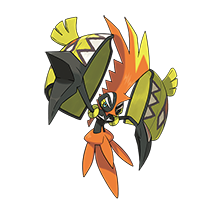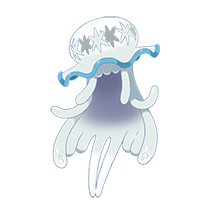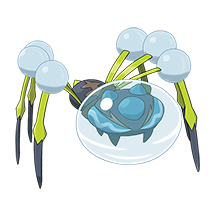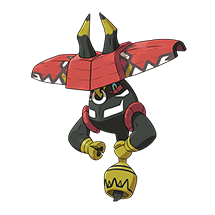Trainers will soon put their best Pokémon Sun and Pokémon Moon strategies on display in Indianapolis, Indiana, at the first-ever North American International Championships. Battles will be streaming live June 30 – July 2 on Pokemon.com/Live, so make sure to tune in! We’re going to witness amazing battles as the top Trainers from Europe, Latin America, and Oceania cross oceans to compete against local talent. The first matches will start around 9:30 a.m. EDT on Friday.
Trainers will be competing for a prize pool of up to $200,000 (based on attendance), spread between the Pokémon TCG and VG competitions. It will also be the final opportunity for Trainers to earn enough Championship Points to qualify for the 2017 Pokémon World Championships.
With so much at stake, Trainers are sure to try to shake up the metagame with innovative Pokémon choices and creative battling tactics. This is one show you won’t want to miss! Read on to find out more about the tournament format and to see some recent teams that could impact Internationals. Whether you’re a veteran of the Video Game Championships or you’re just starting your Pokémon adventures, it’s easy to get caught up and enjoy the event.
Tournament Format
Tournaments this season use the Double Battle format to highlight Pokémon originally discovered in the Alola region. Trainers can select only Pokémon from the Alola Pokédex that have the black clover symbol indicating they were caught, traded, hatched from Eggs, or received as a Mystery Gift in Pokémon Sun or Pokémon Moon. They may give their Pokémon items to hold, but they can’t select more than one of the same held item or Pokémon for their team. Z-Crystals are fair game, but Mega Stones are prohibited—so you won’t see Mega Kangaskhan this time! Some Legendary and Mythical Pokémon are prohibited, too, so you won’t see Magearna, Lunala, or Solgaleo, either.
 Masters Division Trainers will start competing in Swiss
rounds on Friday, and all Trainers with two or fewer losses will move on to
Saturday. After more Swiss rounds, the top players will move on to a
single-elimination top-cut stage to determine the North America International
Champion. Each round is best-of-three, so a Trainer must come out on top in two
games to win each match.
Masters Division Trainers will start competing in Swiss
rounds on Friday, and all Trainers with two or fewer losses will move on to
Saturday. After more Swiss rounds, the top players will move on to a
single-elimination top-cut stage to determine the North America International
Champion. Each round is best-of-three, so a Trainer must come out on top in two
games to win each match.
If you haven’t tuned in since the release of Pokémon Sun and Pokémon Moon, more than just Dugtrio’s stylish new hair has changed. Terrains weren’t groundbreaking in past seasons, but now each of the tapu has an Ability that creates special terrain as it enters the battlefield—check out this handy guide for more information. Sitrus Berries were the healing item of choice for Trainers in past seasons, but now most Trainers have their Pokémon munch on Berries like Figy Berries that activate later in battle and restore more HP instead. Finally, Z-Moves are much more flexible than the Gems that Trainers used in their battles in the Unova region. Keep an eye out for Pokémon that know moves that in past tournaments wouldn’t have been very effective but now have surprising new effects when powered up with a Z-Crystal.
Champs-in-the-Making
Trainers looking to come out on top gravitate toward the Pokémon that have the greatest impact in battle. These Trainers are playing to win, so expect to see plenty of high-powered Pokémon like Tapu Koko, Garchomp, and Kartana all weekend long. But making a team full of strong Pokémon isn’t enough to win—any Trainer could do that. The Trainers who perform best are the ones who craft a team of Pokémon that are powerful, work well together, and match up well against the Pokémon their opponents bring to the fight.
Take a look at some top teams from recent tournaments that could impact Indianapolis. If you’re comfortable with these teams and Pokémon, you’re well on your way to mastering this year’s metagame. We can’t list every key team here, so consider checking out the Championship Series Event Results to see winning teams from many of this season’s events.
The New Normal
Preparation for the 2017 Video Game Championships starts with the Pokémon on this team—if a Trainer’s team struggles with these Pokémon, it won’t go far. Robert’s team combined two of the most popular groupings of Pokémon—the trio of Arcanine, Kartana, and Tapu Fini, and the duo of Porygon2 and Gigalith. We’d be surprised to see these Pokémon win it all as a unit, but don’t expect any of its members to be indie picks in Indy.
Arcanine, the highly offensive Kartana, and the more defensive Tapu Fini may seem a little mismatched, but they’re the backbone of many teams. Arcanine is a tough Pokémon to exclude from any team because the Alola region features few Fire-type Pokémon and few Pokémon with the Intimidate Ability. Trainers need these traits so they can set Arcanine against opposing Kartana, an extremely potent attacker. This team can defend its own Kartana by switching it out for the sturdy Water-type Tapu Fini when opposing Arcanine come into play. The three Pokémon cover each other’s weaknesses well, making them safe picks for most matches.
The duo of Gigalith and Porygon2 provides safety and flexibility. Porygon2 is one of the sturdiest Pokémon in the format overall, which helps it use Trick Room to help its teammates go first on key turns. The slow Gigalith can be devastating under the effects of Trick Room, and it provides further value to its team with the Sand Stream Ability. Ninetales, Torkoal, and Pelipper are tricky opponents because their Abilities change the weather, but each is much more manageable with Sand Stream available to control the skies.
Poison from Another Dimension
Trainers should be wary of the Ultra Beasts Andrew used to win the Regional Championship in Madison, Wisconsin, which streamed earlier this month. Most Trainers include a tapu or two on their teams, so Trainers like Andrew responded by including more Poison-type attacks on their teams. Pheromosa’s Poison Jab and Nihilego’s Sludge Bomb make them nightmarish opponents for the tapu individually—together, they can stop Trainers from executing their tapu-based strategies completely. Both Ultra Beasts can also deal outrageous damage using attacks of other types, making it difficult for other Pokémon to switch into battle safely to protect their Fairy-type teammates.
Another Pokémon from Andrew’s team that drew some attention is Tapu Bulu. Many Trainers have been quick to dub Tapu Bulu the weakest Tapu, but that perception itself could help it Grassy Surge into the limelight. All four tapu are powerful Pokémon, but none are so powerful that they perform well against teams focused on them. With Tapu Koko, Tapu Lele, and even Tapu Fini garnering most of the attention, Trainers won’t need to succumb to Nature’s Madness to include Tapu Bulu on their teams.
Ice, Ice, Maybe
Each of Martin’s Pokémon are great choices, and Ninetales could have been particularly impactful at the North American International Championships.
New in Pokémon Sun and Pokémon Moon, Ninetales’s Aurora Veil move reduces the special and physical damage its team receives for five turns—effectively giving its team both Reflect and Light Screen at the same time. Trainers were excited to try out this powerful new tactic early in the season, but most swore off Ninetales because of its poor defensive stats and damage output.
Despite Snow Warning being themed around Hail, everything changed for Ninetales this spring. With more experience, Trainers started training Ninetales differently. Instead of maximizing Ninetales’s Special Attack and Speed, Trainers shifted toward more defensive builds that could endure more hits. They also solidified Ninetales’s snowy support by teaching it Icy Wind, which reduces the Speed of both opponents.
Ninetales is still a risky choice, but the combination of damage reduction and speed reduction makes for an interesting proposition. We don’t expect the Fox Pokémon to be left out in the cold on Friday, but how deep Ninetales digs into the tournament will be a key story to track.
A Little Help from Friends
In addition to netting another win for the delightfully controversial Tapu Bulu, Nick Navarre’s Regional-winning team showed off a tactic rarely seen in the Video Game Championships—Heal Pulse. This team’s healer is little Clefairy, a Pokémon that seems to make an impact each season due to the move Follow Me and the Ability Friend Guard.
 Clefairy’s main job is to make its teammates as frustrating
to defeat as possible, so naturally its main partner on this team is Snorlax, a
Pokémon that has been blocking Trainers’ paths for years. The Sleeping Pokémon
is difficult to knock out even without support—it can increase its Defense
using Curse, and it starts with a mountain of HP and can get even more by devouring
a buffet of Figy Berries using the Recycle move.
Clefairy’s main job is to make its teammates as frustrating
to defeat as possible, so naturally its main partner on this team is Snorlax, a
Pokémon that has been blocking Trainers’ paths for years. The Sleeping Pokémon
is difficult to knock out even without support—it can increase its Defense
using Curse, and it starts with a mountain of HP and can get even more by devouring
a buffet of Figy Berries using the Recycle move.
Snorlax is almost immovable with Clefairy helping it (even if you have the Poké Flute). Not only does Clefairy’s Friend Guard Ability reduce the damage Snorlax takes, but Clefairy’s presence alone creates tricky guessing games for its opponent. If it successfully heals Snorlax with Heal Pulse too many times, the battle is sure to be lost. But if the opponent attacks Clefairy to stop Heal Pulse while Clefairy is using Protect instead, Snorlax gets a free turn to wreak havoc.
Clefairy has shown its power once again, but don’t be surprised if some Trainers in Indianapolis try out the other Pokémon that can learn Heal Pulse instead. Some Trainers have been experimenting with Chansey, and even Slowbro or Slowking could prove to be helpful teammates.
What new surprises do Trainers have up their sleeves? Which strategies will come out on top? These questions and more will be answered in just a few days. Tune in to Pokemon.com/Live to watch the tournament unfold, and keep checking back to Pokemon.com/Strategy after play concludes each day for recaps, analysis, decks, and teams from the North American International Championships.
